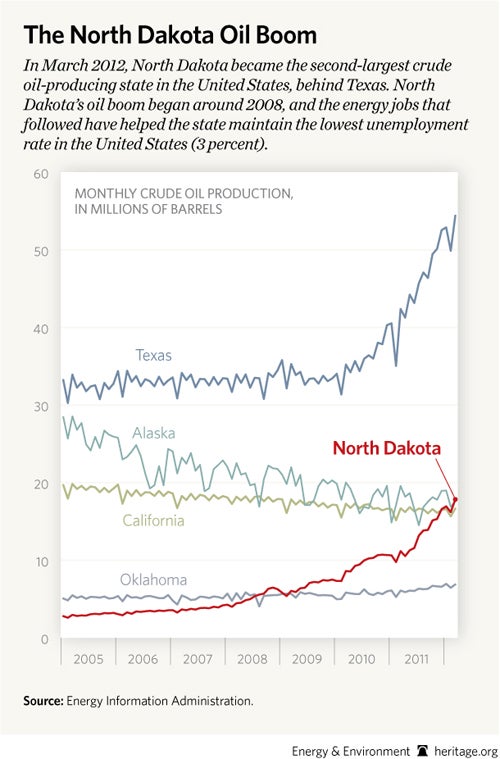The combination of energy production and job creation is potent force. It’s one reason a bipartisan majority in the U.S. House today approved the Domestic Energy and Jobs Act, legislation that would increase access to America’s resources and spur job creation.
With the national unemployment rate still stuck above 8 percent, congressional Republicans hit the road in May to highlight how energy initiatives could cure America’s economic woes. One of the stops was in North Dakota — a state that Heritage and the Institute for Energy Research recently visited.
>> Watch our new video on the North Dakota miracle (below)
The economic boom taking place in North Dakota is a result of fracking in the Bakken oil fields. As this Heritage chart reveals, North Dakota surpassed Alaska in March and California in December to become the second-biggest producer of crude oil in the United States.
It was made possible by sensible state regulations, advancements in technology and the ability to drill on private lands. The state is attracting unemployed workers from all corners of the country and boasts an unemployment rate of 3 percent — lowest in the country — with some areas of North Dakota falling to around 1 percent. North Dakota also leads all states with the largest percentage increase in employment over the past year.
Could this happen elsewhere in America? That’s one of the goals of the Domestic Energy and Jobs Act.
Heritage’s Nick Loris says the legislation “would provide America with much needed energy supply and a much needed economic stimulus.” He cites reforms for drilling in Alaska’s National Petroleum Reserve as one of the highlights. This 23-million-acre area on Alaska’s North Slope is owned by the federal government. Yet despite these resources available in Alaska, the state has dropped precipitously as an oil producer in recent years. For a period in the 1980s, Alaska was the leading producer of oil in the United States.
The Domestic Energy and Jobs Act would speed up the lengthy permit process for energy production in Alaska’s Natural Petroleum Reserve by requiring the Department of the Interior to approve drilling permits in 60 days and infrastructure permits in six months. Such a move might not be enough to overtake North Dakota in production, but it could help Alaska reverse its downward trend in oil production.
The above chart was created by John Fleming, Heritage’s senior data graphics editor. The U.S. Energy Information Administration provided the data.






























One Reply to “North Dakota’s Oil Boom in Pictures”